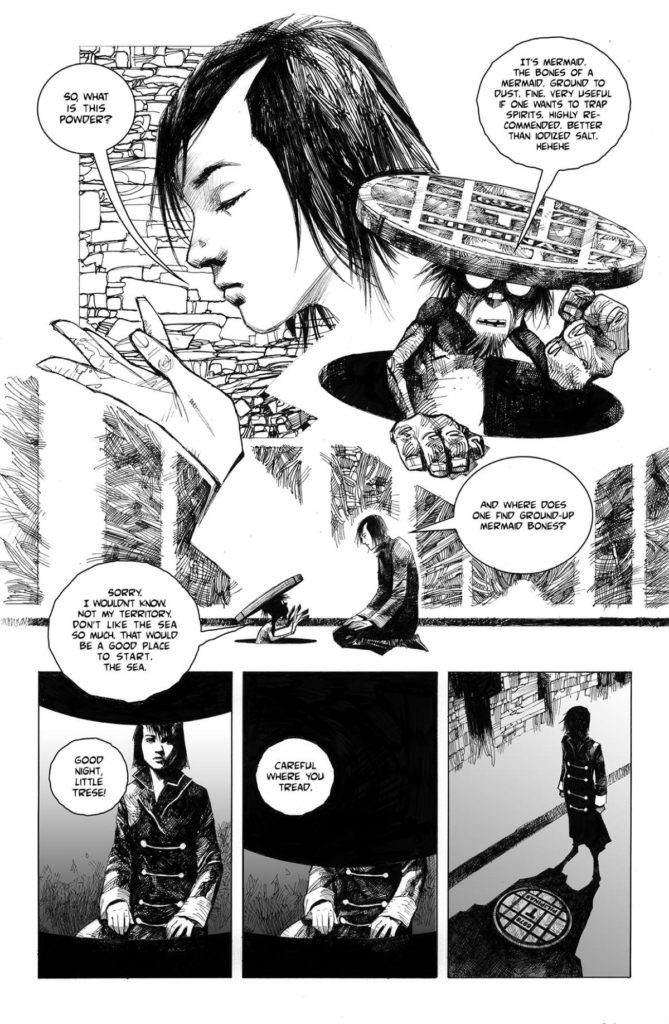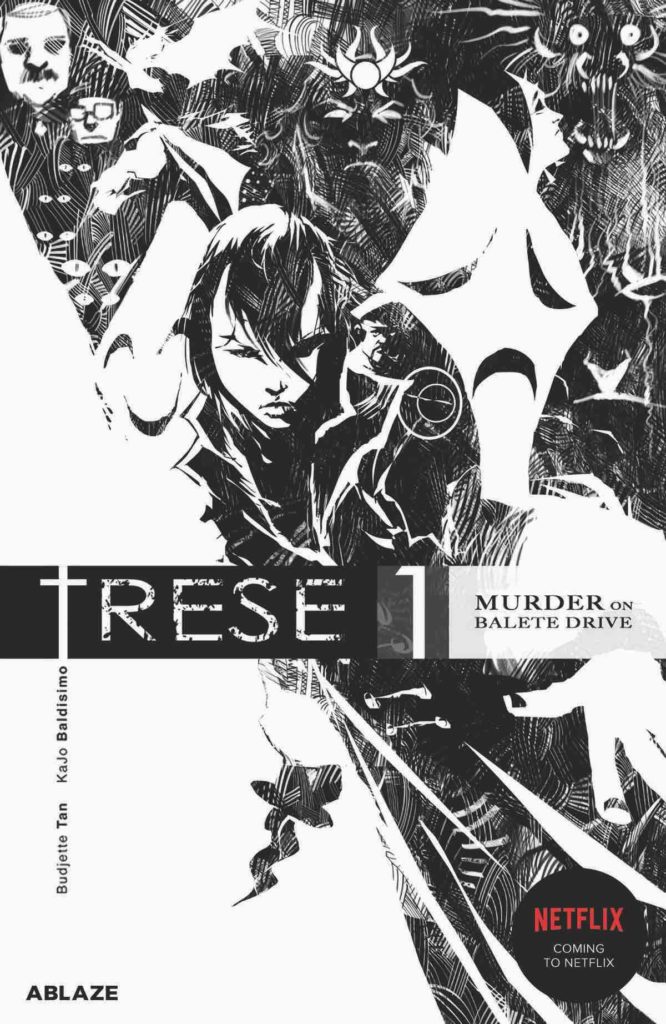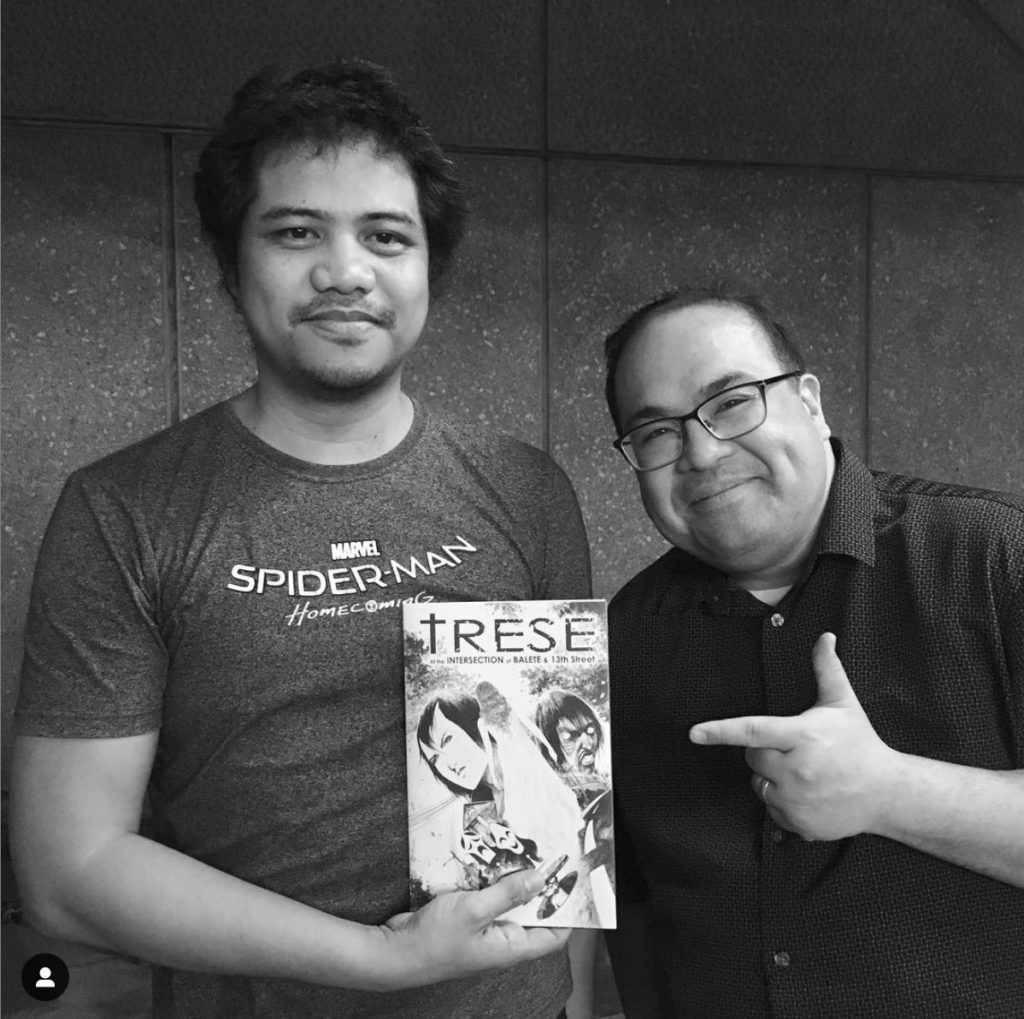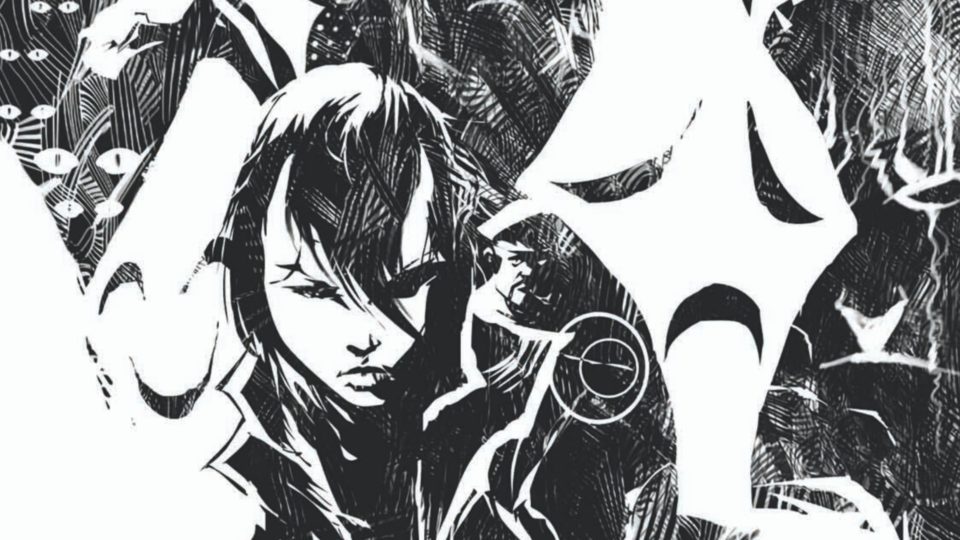Mark the date: Sept. 30, 2020.
That’s when United States-based publisher Ablaze is set to release cult comic book Trese to readers in the country, in Canada, and even farther.
The crime-horror serial about a gun-toting, monster-busting heroine named Alexandra Trese, and her noir-backdropped romp through Manila’s supernatural underbelly has been well received by comic fans not limited to the Philippines. So much so that Netflix announced over a year ago that it will adapt the title into an an animé series (more details on that later).
After raking in several awards, including Best Graphic Literature in the 29th National Book Award in 2010, you wouldn’t have guessed that the book’s early editions were photocopied.
Why the mainstream appeal?
For one, its heroine was inspired by beloved popular and cult fictional heroes battling crime, the supernatural, or both.
“[Alexandra Trese] was based on Batman, John Constantine, Fox Mulder, and Karl Kolchak,” Trese‘s writer Budjette Tan told Coconuts Manila over email. But somewhere between the eponymous character’s inception and publishing, Tan thought Trese would be better off as a female character, and his co-collaborator, artist Kajo Baldisimo was quick on the uptake.
“He sent me a sketch of Trese as a woman and it all clicked,” he said.

Tan wrote the comic with Baldisimo over a decade back while he was working at an advertising agency. These days, the veteran creative is based in Denmark, where he’s been working as a senior brand creative for Lego (yes, that Lego) for the past four years.
“It’s fun because we get to play with the new sets a year before they come out. Me and my family are now based in Billund, which is the town where LEGO was created and it’s also the place of the main LEGO office,” Tan said, confirming that his day job is just as exciting as it sounds.
We spoke with the creative tour-de-force in length about the acclaimed book’s humble roots, local titles that excite him, and Trese’s inevitable global domination.
The following interview responses have been lightly edited for flow and clarity.
Cheers to Trese getting picked up by a U.S. publisher. How does that feel after writing and publishing the comic more than a decade ago?
Of course, it feels great to know that Trese will finally reach bookstores and comic book shops in the US and Canada—and beyond. We will be distributed by Diamond Distribution, which means any comic book or bookstore around the world that orders from them can order Trese.
That’s cool. But do you somehow feel that the international publishing deal should have come sooner? Back then publishing the book wasn’t as easy, was it?
Me and Kajo started Trese back in 2005, back then when we just photocopied it.
Then in 2007, we had eight complete issues and we pitched it to Visprint [Publishing] and they picked us up, and that became Trese Books 1 and 2. Ever since then, I’d send copies of Trese to U.S. publishers. Sometimes we don’t get a reply. Sometimes we’d get a rejection letter.
Do you feel that Ablaze’s decision to pick up the comic book had to do with Trese being bound for a Netflix release?
Yup, I think it was after that news about Trese being part of Netflix’s new animé lineup that we got an email from Ablaze. It was also around this time when our Indiegogo project was ongoing and we got featured in the comic book news site Newsarama.
When Ablaze talked to us, they already have another comic book title that was also going to be adapted into an animé by Netflix. Their other titles are all comic books from Europe, Japan, and Korea. So, it feels great to be part of that line up of titles that will be introduced to new readers in North America.
What will be different in the U.S. edition, and in which areas in the U.S. will Trese Vol. 1 be set for release? Will there be more volumes or single issues?
This volume contains the same four stories in the first Trese book. It will contain [a] brand new art. Kajo decided to redraw his pages from 2005, so readers will see the same case, but now drawn in Kajo’s latest art style. We’ve also added pages for each story, so readers will see more of Trese in action!
To help our new readers learn more about Philippine myth and folklore, we’ve added bonus material, in the form of journal entries from Trese’s grandfather, Prof. Alexander Trese, where he writes and explains these creatures, like the aswang [shapeshifting monster] and nuno [dwarf-like elemental].
It will also be printed in U.S. comic book size, so it’ll be bigger than the first printing of Trese. With this bigger size, readers can better appreciate Kajo’s new detailed artwork.

Visprint announced that it’s closing down by 2021. How much impact does that have on the local comic book scene? Is Trese still being published in the Philippines?
Trese will continue to be published in the Philippines by Avenida. That’s one of the things we wanted to make sure— that we can continue to print a Philippine-edition of Trese, so we can keep the cover price affordable.
Visprint closing down means that’s one less publisher that’s willing to be on local comic book creators. But when Visprint started publishing comics in 2005 – when they started with Carlo Vergara’s Zsazsa Zaturnnah and Manix Abrera’s Kikomachine – they were one of the few publishers that did that. Years later, after Visprint showed the way and that publishing new Filipino comic books is not risky, we’ve seen more new and old publishers release more Pinoy comic books.
So, even with their closing down, I’d to think they’ve helped inspire a new generation of comic book creators and publishers.
We’re not sure how much of today’s younger generation still has access to printed comic books, but do you feel that transitioning into animated films is the natural next progression? Are Pinoy comic books in danger of being phased out?
“Comic books are dying!” “Komiks is dead!” We tend to see these headlines every couple of years, and yet, we’re still around. Right?
Back in 2006, we uploaded the first three issues of cases of Trese on our blog. Some people asked me if I was afraid people might pirate our works or not want to buy it since they’ve already read it. The interesting feedback we got was from people who said, “I just read this—where can I buy the book?”
I think, whatever happens, we still want to hold on to something. So even if we read a webcomic, if we really like it, then we’d want to have a printed version or the t-shirt or the action figure of the characters. So, whatever happens, I think I’ll always tell my stories through the comic book medium.
Having an animated series, for me, is a great way to reach new readers. When I was a kid, I was introduced to Batman and Spider-Man through the TV shows. Later on, when I learned there were more stories about them in comics, that’s when I started collecting their series. So I hope the Trese animé series will be a way for people to learn about our comic book.
How do you feel the local comic book industry compares versus the comic book scene in the rest of the world? Do you think Pinoy comics is where we should be now?
Talent-wise, we definitely had great writers and artists that need to be read by more people around the country and more people around the world.
Industry-wise, we’re still pretty small compared to the mega-manga industry of Japan or the American comic book industry.
I think a lot of people dream that our comic book scene reaches a level when it becomes profitable enough to become a regular job for writers and artists. I feel we still need to figure out how to efficiently promote and distribute the book so that it would reach more people around the country and the world.
What are your thoughts on self-publishing?
Self-publishing is a great way to learn about the business side of making comics. I hope new and old comic book creators give it a try, even if they have plans to work with an existing publisher.
We’re excited about Trese’s debut on Netflix by the way. Are you allowed to divulge a tentative date or timeline for when it’s set to stream?
Nope. Hahaha!
Fair enough. But will the animé be a faithful adaptation or a reboot of the original?
If you’re a fan of the book, I think you’ll enjoy it and still be surprised even though you know what’s going to happen in the story.
What kind of challenges are you facing producing it? How much involvement do you and Kajo Baldisimo have on the series with Netflix?
The production of the anime is under the direction of Jay Oliva, the show’s executive producer and show-runner, along with our producers from BASE Entertainment, Tanya Yuson and Shanty Harmayn.
Me and Kajo got to meet the team last year and helped answer their questions about the characters and stories. After that, they started working on it and I get to see some progress whenever I meet up with our producer.

Read: First-ever Pinay version of ‘Buffy the Vampire Slayer’ unveiled in PH-exclusive cover
Kajo also recently did a Philippine exclusive cover of Buffy featuring a Pinay slayer. He mentioned it’s similar to Trese because they’re both ass-kicking females. Were there less strong female characters in the local scene back then when you first wrote it?
Looking back, Darna was probably the first Pinoy superhero I learned about. In the past 10 to 20 years, I guess other strong female characters would be Carlo Vergara’s Zsazsa Zaturnnah and in Arnold Arre’s The Mythology Class, some of his best characters there were his female leads.
I don’t think Filipino comics have had a lack of strong female characters.
When I created Trese, the template was based on Batman, John Constantine, Fox Mulder, and Karl Kolchak. So, when I wrote those first drafts, it didn’t feel right – it’s felt typical to me—and when wondered, what if we made Trese a woman, then it sounded more interesting. I texted Kajo this new thought and on the same day, he sent me a new sketch of Trese as a woman and then it just all clicked for me and him.
The nice thing about the local comic book scene is that we’ve got variety in our stories and characters.
Any Filipino comic creators that you can recommend who are doing good work but are slipping under the radar? Or any local titles and authors that you’re really excited about?
I’ve been based abroad for the past four years, so I don’t think I’m that up-to-date with the new comic book creators. Whenever I come home for Christmas, I try my best to buy the new local titles that were released during the year.
My new favorite is Julius Villanueva’s Ella Arcangel, which tells the story of a young mambabarang [sorcerer] who lives in the slums and is the protector of her neighborhood from the forces of darkness.
Read: Artist Mervin Malonzo forays into animated horror in this adaptation of ‘Ella Arcangel’
Yeah, we enjoyed that, too. Do you still remember the first comic book you read as a kid or the first time you got really hooked into comic books?
I didn’t get a lot of comic books when I was a kid. So the few comic books that I have, I read over and over again. My parents got me these thick Marvel comic books that compile all of the origins of their superheroes. They also got me these digest comics that compile the secret origins of DC heroes and villains. That’s how I became familiar with all those characters.
Later on, my friend gave me a birthday gift: Uncanny X-Men # 188 and 189 – which is what got me hooked on the X-Men. Around that same time, we discovered [comic book store] Filbar’s, which was their first branch in Virra Mall, a small stall under the escalator. They were the first comic book store in Manila that brought in new comics every week. So, that became the reason I started to collect comics on a more regular basis.
When did you know that you were meant to create a comic book instead of just consume it?
I made my first comic book “Cosmic Man” when I was in Grade 4 or 5. I wrote my first short “Stardart” when I was in Grade 6. I wrote my first novel “The Wizard’s Keep” when I was in Grade 7. I wrote my first TV script “Blasco: Psychic Detective” when I was in high school. After trying all those different formats, I still went back to writing comics.
I guess creating comics for me was love at first sight.




